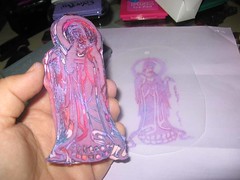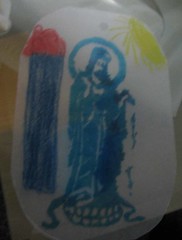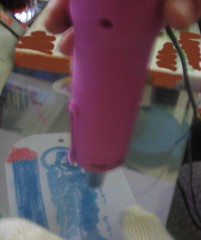Long a favorite ceremony of mine, this portion does take about ten minutes to chant, and the pattern of the beats can be unexpected and difficult to chant. I had chosen a challenging lesson for the girls on this first Sunday in April.
Since this would also be the last lesson where we created something, I wanted that to be special as well. I know the kids always love shrinky dinks, and that was something I've wanted to do all year. These take time, another challenge to add to the mix.
Since the chanting would take the place of meditation, we started out the lesson with a quick check-in. After Kim and I demonstrated a stanza, we all practiced the same stanza. I made sure the girls knew about the repeating line "By mindfully invoking Kanzeon's power" so if they got lost, they could join in again at that line. I explained this wasn't easy to chant, and no doubt we would make mistakes, but it would all be okay. We then proceeded to do pretty well, and made it through the ten minute chant without mishap.
At the beginning of the lesson, I explained that with this practice we chant not so much to comprehend every thing at once, but to let bits of the chant arise and catch our attention. Since this would be their first reading of the scripture, what I would do is read it to them after we did the chanting, while they started on the surprise activity.
Kim helped the girls stamp their shrink plastic while I read the scripture again. We encouraged them to draw images that came to mind from the reading. They quietly listened as they chose colored pencils and enhanced the simple picture of Kanzeon. I finished reading about the time the first girl was ready for shrinking. Using an embossing heat tool, I saved our large pieces from curling up on themselves with an Ove Glove. The larger the piece, the harder it is to keep the shrinky dink from getting all buckled and curled. This way I could touch the hot plastic and push it flat.
Stamp and shrink process:





Since we had so much to pack into one lesson, we didn't have a chance to talk about it. We'll have some chances to review in upcoming lessons. Some of the girls remember lessons on the Bodhisattva Kanzeon from last year.